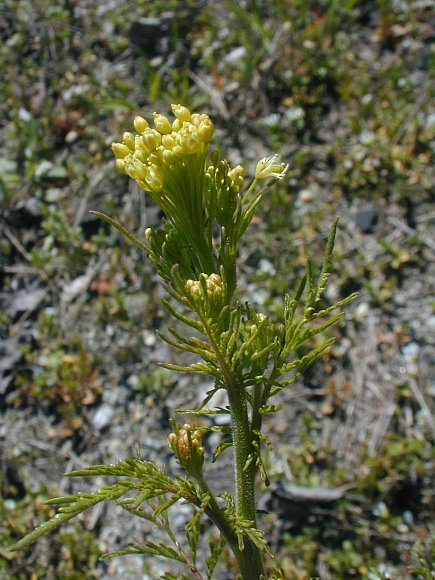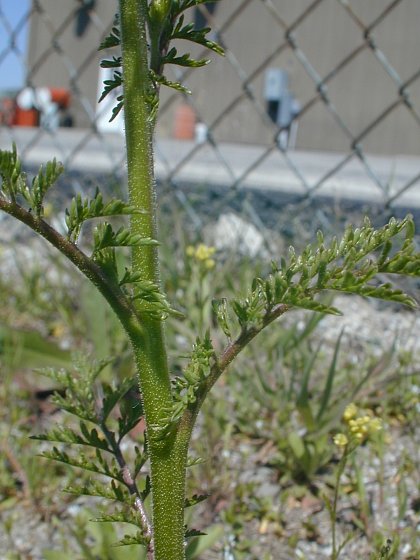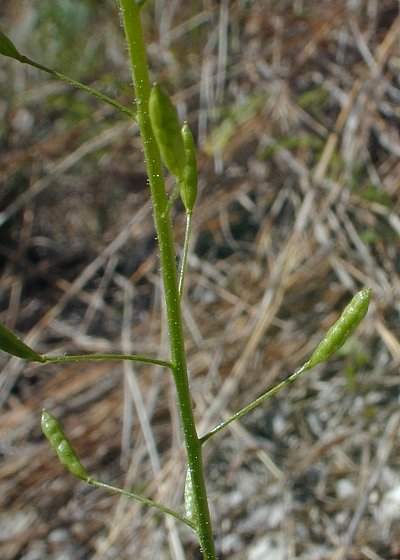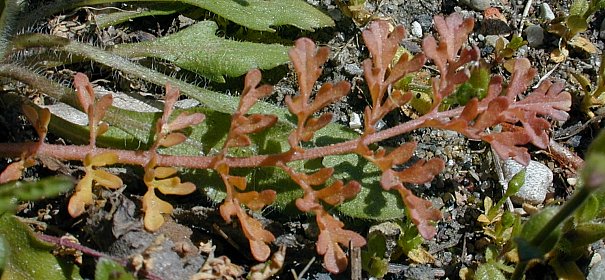Description: This biennial or annual plant is ½–2' tall. It branches sparingly and is more or less erect. The round stems are covered with short glandular hairs. Young plants consist of a low rosette of basal leaves spanning 4-8" across, from which there develops during the spring a flowering stalk with alternate leaves. These cauline leaves are up to 8" long and 4" across. They are double or triple pinnately lobed and glabrous or slightly pubescent. The narrow lobes are oblong to oblanceolate, providing the cauline leaves with a fern-like appearance; the lobes become more narrow in the upper cauline leaves. The basal leaves are quite similar to the lower and middle cauline leaves in appearance. The foliage of Tansy Mustard is usually some shade of green. The petioles of the leaves are rather long, although they become progressively shorter as the cauline leaves ascend the stems.

The upper stems terminate in racemes of flowers about 2-12" in length. The small yellow flowers bloom in whorls at the apex of each raceme, while the siliques (slender seedpods) develop below. Each flower spans about 1/8" (3 mm.) across, consisting of 4 pale yellow petals, 4 green sepals, 6 stamens with yellow anthers, and a pistil with a stout style. The petals are about the same length as the sepals; they are both oblong-lanceolate. The blooming period occurs from mid- to late spring and lasts about 2 months. There is no noticeable floral scent. Each flower is replaced by a cylindrical silique that is about 1/3" (8 mm.) long. This silique contains two rows of tiny seeds that are separated by a fine membrane. The spreading pedicels of the siliques (or flowers) are about ½" long when they are fully mature; the siliques angle upward from their pedicels and are more ascending. The tiny seeds are somewhat flattened, oblongoid or ovoid, and some shade orange-brown. They are small enough to be blown about by the wind. The root system consists of a stout taproot. This plant spreads by reseeding itself and often forms loose colonies.

Cultivation:
Tansy
Mustard is typically found in full sun, mesic to dry conditions, and
sterile soil that is sandy or gravelly. It also grows readily in
fertile soil in open disturbed areas, in which case the plants will be
larger in size.
Range & Habitat:
Tansy Mustard is an occasional plant that is widely distributed in
central and northern Illinois; it less common or absent in many areas
of southern Illinois (see Distribution
Map). However, along railroads, this plant is rather common.
It is native to both the Old World and New World (including Illinois);
some local populations in disturbed areas may be adventive from
Eurasia. Habitats include gravelly prairies, sandstone and limestone
glades, rocky bluffs and cliffs, areas along roads and railroads
(including the ballast), fields, and sterile waste areas. Disturbed
areas are preferred, although this plant also occurs in higher quality
natural habitats.

Faunal Associations: The nectar and pollen of the flowers attract Syrphid flies and possibly other insects. The caterpillars of the butterflies Pieris rapae (Cabbage White), Pontia protodice (Checkered White), and Anthocharis midea (Falcate Orangetip) feed on the foliage. Little is known about this plant's relationships to birds and mammalian herbivores in the Eastern states; however, in the drier Western states various species of quail eat the seedpods, while Bighorn Sheep, elk, and mule deer eat the foliage sparingly. The foliage is somewhat toxic to horses and cattle; it can cause blindness, staggering, and paralysis of the tongue if consumed in large quantities over a sufficiently long period of time. Sheep and goats are more immune to the toxic properties of the foliage. Because the tiny seeds become sticky when wet, it is possible that they are transported by the feathers of birds, the fur of animals, and the shoes of humans.

Photographic
Location:
Gravelly areas along railroads in Urbana and Savoy, Illinois.
Comments:
Tansy Mustard is one of the earliest plants to bloom along railroads,
although it is usually rather small-sized and inconspicuous. It is
somewhat similar in appearance to the adventive Descurainia
sophia (Flixweed), and differs from this latter plant by its
greener foliage, earlier bloom, and the shape of its siliques, which
are broader (about 1.5 mm. in diameter) and shorter (about 1/3" or 8
mm. in
length). Flixweed has greyish blue foliage and a tendency to bloom
later. Its siliques are narrower (about 1.0 mm. in diameter) and longer
(about 1" in length). While the seeds of Tansy Mustard are arranged in
two rows in each silique, the seeds of Flixweed are arranged in a
single row. The typical variety of Tansy Mustard doesn't occur in
Illinois; it has longer seedpods.